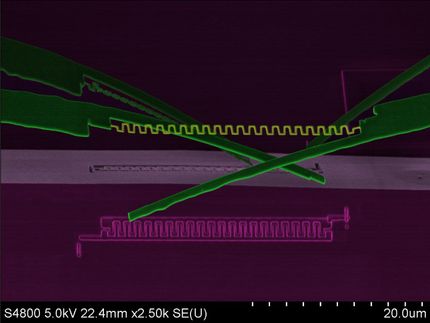Your Monitor as an Analytical Tool
Detection of amines, CO, and NOx by computer monitor and web camera
monitoring the environment or groceries with your mobile phone? Diagnostics with a normal PC? Though these things sound farfetched, they are not actually all that absurd. Computers and mobile phones already form a global network. Their ability to capture and transmit images and acoustic signals is continually improving. Could we also use these devices to register chemical and biochemical parameters? A Swedish and Italian research team headed by Ingemar Lundström has now shown how an ordinary computer monitor, a web cam and a simple test strip can be used to detect environmentally important gas molecules such as amines, carbon monoxide (CO), and nitrogen oxides (NOx).
Analysis with common devices would be useful if conventional analytical equipment becomes too expensive or the expertise necessary to use it is lost. There is also the possibility of rapid medical diagnosis in remote areas. Because the location of the user can be determined by satellite, information about environmental contamination can rapidly and easily be placed in a geographical context.
Computer monitors are able to display defined areas of specific form, color, and light intensity, areas that can be rendered in two dimensions with good resolution. Such monitors are thus not a bad light source for an analytical system. The necessary computational capacity is already available-in the PC that is plugged into the monitor. As sensors for the gas molecules they wished to detect, the scientists chose to use porphyrin dyes-examples of which we can see in red hemoglobin and green chlorophyll. Depending on how they are configured or whether they are associated with certain metal atoms, porphyrins have a variety of colors. Many react by changing color when specific gas molecules bind to them.
The researchers mixed three different porphyrin pigments in a polymer and put small drops of the polymer on a glass slide and attached it to a monitor. They then had the monitor display a rainbow of 50 colors. On the monitor, each color is generated through different intensities of the three color elements, red, green and blue. In the meantime, a web cam records the absorption and fluorescence intensities of the three dabs in all three elements. If amines, CO, or NOx are present in the air being tested, the spectra recorded change in such a characteristic fashion that "fingerprints" are obtained. The gases present in the environment can be detected and identified by their fingerprints.
Original publication: I. Lundström et al.; "Chemical Sensing with Familiar Devices"; Angewandte Chemie International Edition 2006, 45, No. 23, 3800-3803.
Most read news
Topics
Organizations

Get the analytics and lab tech industry in your inbox
By submitting this form you agree that LUMITOS AG will send you the newsletter(s) selected above by email. Your data will not be passed on to third parties. Your data will be stored and processed in accordance with our data protection regulations. LUMITOS may contact you by email for the purpose of advertising or market and opinion surveys. You can revoke your consent at any time without giving reasons to LUMITOS AG, Ernst-Augustin-Str. 2, 12489 Berlin, Germany or by e-mail at revoke@lumitos.com with effect for the future. In addition, each email contains a link to unsubscribe from the corresponding newsletter.























































